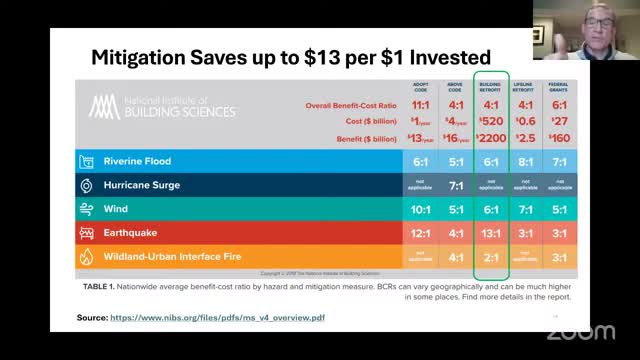Connecticut Red Cross highlights urgent need for disaster resilience amid rising climate impacts
December 18, 2024 | Insurance and Real Estate, House of Representatives, Committees, Legislative, Connecticut
This article was created by AI summarizing key points discussed. AI makes mistakes, so for full details and context, please refer to the video of the full meeting. Please report any errors so we can fix them. Report an error »

On December 18, 2024, the Connecticut Insurance Department's Weather Mitigation and Resiliency Advisory Council convened to discuss critical issues surrounding climate change, disaster response, and community resilience. The meeting highlighted the increasing frequency and economic toll of severe weather events, emphasizing the urgent need for enhanced mitigation strategies.
The discussions began with a presentation by Jeffrey, who underscored the effectiveness of mitigation efforts, particularly in relation to building codes and retrofitting. He noted that while property damage is often the most visible impact of disasters, the broader consequences—including environmental degradation and mental health effects—must also be considered. This holistic view of risk management is essential for developing comprehensive strategies that not only protect physical assets but also bolster community resilience.
A significant point raised during the meeting was the alarming trend of rising costs associated with weather-related events. Jeffrey referenced data indicating that Connecticut has experienced a marked increase in both the number and economic impact of such events, which reinforces the necessity for proactive measures. The discussion also touched on the critical role of property insurance in mitigating these impacts, with a striking statistic presented: for every dollar invested in mitigation, there is a potential return of $13 in avoided losses.
Richard Brannigan from the American Red Cross followed with insights into the human toll of disasters, particularly on vulnerable populations. He highlighted the relentless cycle of disaster response that the organization faces, noting that recent years have seen an unprecedented number of simultaneous disasters across the country. Brannigan emphasized that those most affected are often the least equipped to recover, citing socioeconomic factors that compound the challenges faced by low-income individuals and families.
Brannigan's presentation included sobering statistics about food insecurity and housing instability in Connecticut, where one in eight residents faces food insecurity. He illustrated the compounded effects of disasters on these populations, particularly during power outages that lead to food spoilage and loss of income. The discussion also revealed that many individuals lack adequate insurance coverage, leaving them vulnerable in the aftermath of disasters.
The meeting concluded with a call to action for more robust infrastructure planning and community support systems to address these multifaceted challenges. The council's discussions underscored the importance of integrating mitigation efforts into broader disaster preparedness and recovery strategies, ensuring that all community members, especially the most vulnerable, are equipped to withstand and recover from the impacts of climate change.
As Connecticut continues to grapple with the realities of climate-related disasters, the insights shared during this meeting will be pivotal in shaping future policies and initiatives aimed at enhancing community resilience and safeguarding the well-being of its residents.
The discussions began with a presentation by Jeffrey, who underscored the effectiveness of mitigation efforts, particularly in relation to building codes and retrofitting. He noted that while property damage is often the most visible impact of disasters, the broader consequences—including environmental degradation and mental health effects—must also be considered. This holistic view of risk management is essential for developing comprehensive strategies that not only protect physical assets but also bolster community resilience.
A significant point raised during the meeting was the alarming trend of rising costs associated with weather-related events. Jeffrey referenced data indicating that Connecticut has experienced a marked increase in both the number and economic impact of such events, which reinforces the necessity for proactive measures. The discussion also touched on the critical role of property insurance in mitigating these impacts, with a striking statistic presented: for every dollar invested in mitigation, there is a potential return of $13 in avoided losses.
Richard Brannigan from the American Red Cross followed with insights into the human toll of disasters, particularly on vulnerable populations. He highlighted the relentless cycle of disaster response that the organization faces, noting that recent years have seen an unprecedented number of simultaneous disasters across the country. Brannigan emphasized that those most affected are often the least equipped to recover, citing socioeconomic factors that compound the challenges faced by low-income individuals and families.
Brannigan's presentation included sobering statistics about food insecurity and housing instability in Connecticut, where one in eight residents faces food insecurity. He illustrated the compounded effects of disasters on these populations, particularly during power outages that lead to food spoilage and loss of income. The discussion also revealed that many individuals lack adequate insurance coverage, leaving them vulnerable in the aftermath of disasters.
The meeting concluded with a call to action for more robust infrastructure planning and community support systems to address these multifaceted challenges. The council's discussions underscored the importance of integrating mitigation efforts into broader disaster preparedness and recovery strategies, ensuring that all community members, especially the most vulnerable, are equipped to withstand and recover from the impacts of climate change.
As Connecticut continues to grapple with the realities of climate-related disasters, the insights shared during this meeting will be pivotal in shaping future policies and initiatives aimed at enhancing community resilience and safeguarding the well-being of its residents.
View full meeting
This article is based on a recent meeting—watch the full video and explore the complete transcript for deeper insights into the discussion.
View full meeting
